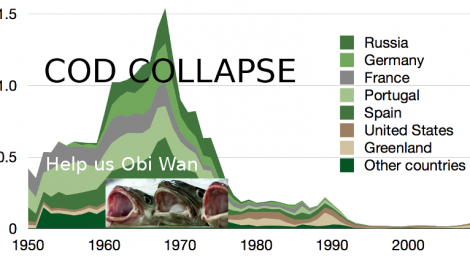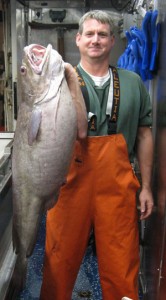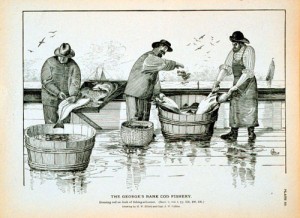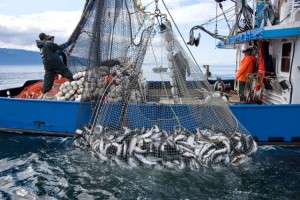
Atlantic Cod Declining Even More — We Can Bring Them Back
More bad news as federal regulators declare populations of Atlantic cod continue to diminish, despite severe cuts in fishing quotas.
Nearly 30 years of ‘conservation’ has failed to help restore the cod. Only by restoring their pasture upon which they are today starving can help them.
We can bring the cod back, but first the bad news.
The National Oceanic and Atmospheric Administration this week announced that new, preliminary data show “virtually every indicator” of the cod stock’s condition declined or worsened in 2013. Through comprehensive fish surveys, the agency found that the population of spawning Gulf of Maine cod has plummeted to between 3 and 4 percent of what it would take to sustain a healthy stock. Juvenile cod populations are seen to be at an all-time low.

Russ Brown NOAA NE Fisheries Science Director with a large Atlantic Cod. Don’t expect to see many of these in the future!
Russell Brown, deputy director of NOAA’s Northeast Fisheries Science Center, on Wednesday said the similarly measured spawning cod levels were between 13 and 18 percent just two years ago. So dropping to 3-4 percent is nothing short of a worst case scenario.
“We’re very concerned about what we’re seeing,” said Brown, who will meet with the New England Fishery Management Council next week to discuss pursing an external peer review of the data.
For all the good that will do more talk about the topic they have been talking, arguing, and doing nothing productive in more than 25 years save seeking tax breaks for the decimated fishing community.
Tax Breaks Don’t Bring Back The Fish
The Secretary of Commerce declared a Northeast ground fishery disaster in 2012 due to the significant quota cuts anticipated in the 2013 fishing year for key ground-fish stocks, including cod. The New England Fishery Management Council, the regional arm of the National Marine Fisheries Service, in May 2013 reduced the cod catch in the Gulf of Maine by 77 percent.
Congress in last year’s budget appropriated for New England ground fishermen $32.8 million in disaster relief aid.
NOAA’s Official Position – Not Enough Fish To Support The Cod Fishery
Scientists have seen and recorded a dramatic and directional shift in the plankton that sustain all the young fish, especially the cod. The ocean cod pastures are simply in a state of total collapse and with that collapse the cod are in worse shape today than ever.
Brown said, “there’s been a series of unsuccessful reproduction seasons during the last four or five years. As a result, there aren’t enough juvenile cod to support the fishery.”
“There are environmental conditions that are changing, and we’re seeing clear signals of that from all fish stocks, not just cod.” “The reproductive success of cod and haddock is largely dependent on oceanographic condition.”
“It’s a pretty complex situation for cod,” Brown said. “The concern is that when there are very low population sizes, things that wouldn’t impact a healthy stock tend to become more significant.”
The New England Fishery Management Council has already proposed closing a large part of Stellwagen Bank to recreational and charter-boat ground fishing in order to protect and research fish habitats.
Atlantic Cod Collapse Is Everywhere
According to a study just published (13 Feb. 2014) in the journal Plos One, the Atlantic Ocean has been changing dramatically over past 40 years. As a result collapse of the main food of juvenile cod specimens is shown to be more critical than the density of breeding adults in the recruitment of this species (read overfishing), reported the IEO.
The scientists determined that the stock of cod in the North Sea experienced a dramatic reduction over the past four decades. And the two main factors that are considered responsible for this decline are the reduction in productivity of ocean fish pastures and of course over-fishing what few fish are left on the dying ocean pastures.
Call To Action – Restore Ocean Cod Pastures Without Delay
Ocean pastures like those on land have a carrying capacity for “livestock/fish” proportional to their primary productivity. When a pasture has no grass it can sustain no livestock. Ocean pasture grass is plankton. Walt Whitman said it succinctly “All beef is grass.” said he. I say, “All Cod is plankton.”
Tragically the North Atlantic ocean pastures are suffering dramatic productivity declines as one of the many deleterious effects of high and rising CO2 in the world’s atmosphere. We can replenish and restore them to bring back the fish.
Here’s how it simply works. Today’s high CO2 in the air is helping plants grow on land. Good plant growth on land is called “good ground cover.” That ground cover prevents dust from blowing in the wind and that missing dust was the primary source of mineral micro-nutrients for ocean pastures. Just as we know rain arriving in the wind nourishes and makes a pasture on land grow grass, dust from the wind nourishes and makes the plants of the ocean pasture grow. Without ocean pastures plant life, phyto-plankton, they cannot sustain life, including the Atlantic Cod.
Atlantic ocean plant life, the phyto-plankton, has been observed to be in tremendous decline. International science teams have measured more than 26% lost in the last 30 years. How bad is 26%? Remember when we destroy just 1 in 10 of any form of life we say that we have decimated that life! It’s bad. Very bad. And the starvation and disappearance of Atlantic Cod stand as testimony to the collapse of the Atlantic Ocean Pastures.
NE Pacific Ocean Salmon Pastures Restored To Historic Abundance Bringing Back 500 Million Additional Fish At A Cost Of Just $2.5 million!
My work to restore ocean salmon pastures of the NE Pacific has been successful there is every reason to believe the same simple, immediate, and successful ocean pasture restorations can take place in the North Atlantic to the benefit of Atlantic Cod.
Our restored NE Pacific ocean salmon pasture of 2012 brought back stupendous returns of salmon to Alaska last fall (2013). Where 50 million Pink salmon were expected, instead having been nurtured and sustained on our replenished and restored ocean pasture 226 million Pink Salmon returned to SE Alaska.
On the entire Pacific coast the number of Pink salmon counted last year was more than 650 million where 150 million were expected.
Just now salmon boffins are forecasting that instead of a repeat of last years return of barely 2 million Sockeye Salmon to the Fraser River of British Columbia 72 million of the bright red Sockeye are expected. It will be the largest number in all of history, dwarfing the famed Bristol Bay Sockeye runs in far North Alaska.
It just works with North Pacific salmon, surely it will just work with North Atlantic Cod! And more Atlantic Salmon and Atlantic Cod have always shared the same ocean pastures so as we replenish and restore those Atlantic ocean pastures all fish indeed all of ocean life will benefit.
I have proven my methods and technologies work, at a large scale, immediately, and affordable at a fraction of the cost of tens of millions in more industry subsidies! A better proverb for today’s fisherman is:
“Give a man a fish, and you feed him for a day; show him how to catch fish, and you feed him for a lifetime.”
But you do need to make sure the fish are there. We can do that!
Let them catch fish!
BRING BACK THE COD!










